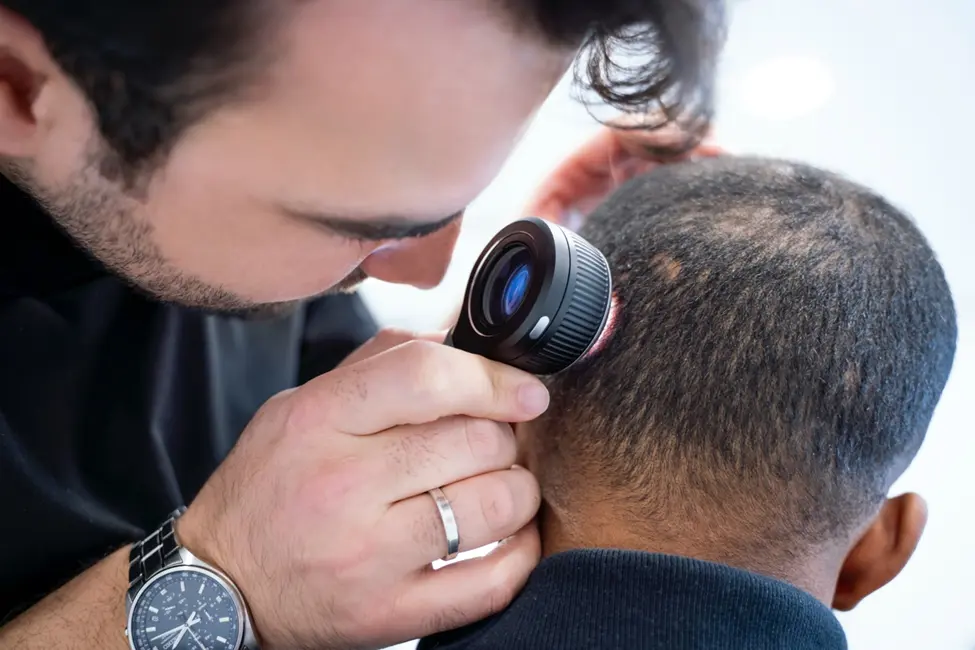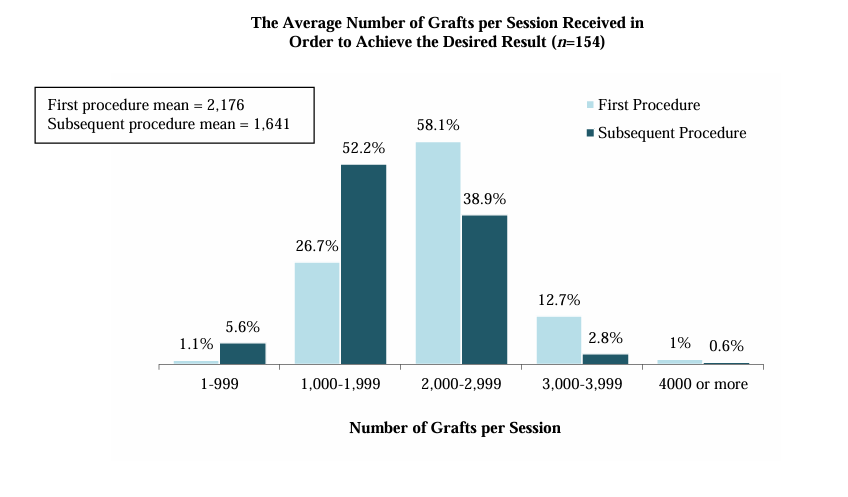How Many Grafts Are Needed for Hair Transplant?
If you’re considering a hair transplant, questions that likely come to mind are: how many grafts are needed for hair transplant? What is the maximum number of grafts that can be transplanted?, etc.. Understanding the number of grafts required helps you set expectations for coverage, density, cost, and long-term results.
In this blog, we answer some of the most commonly searched questions about the number of grafts needed, based on hair loss severity, scalp condition, and donor supply.

What Is A Hair Graft And How Many Hairs Are In One Graft?
Before trying to figure out how many grafts are needed for hair transplant, it’s essential to understand the difference between grafts and hairs. Many people mistakenly assume that one graft equals one hair, but that’s not the case, and this misunderstanding can lead to unrealistic expectations.
A hair graft is a small section of scalp tissue containing a follicular unit, which may include 1 to 4 hair follicles. These follicular units are extracted from the safe donor area and then implanted into balding or sparse areas.
On average, each graft contains about 2 hairs. So, if your surgeon transplants 2,000 grafts, that usually results in roughly 4,000 hairs. However, it’s the graft count that is used in planning and pricing, not the total number of individual hairs. That’s why understanding the graft-to-hair ratio is key when evaluating what’s needed to achieve your desired density.
What Is The Ideal Graft Number For Hair Transplantation?
There is no one-size-fits-all answer when it comes to the ideal graft number for hair transplantation. Each patient has a unique pattern of hair loss, donor hair availability, and long-term goals. A skilled hair transplant surgeon must take a scientific and individualized approach to determine the most effective and sustainable graft count for each case.
How Do Surgeons Determine How Many Grafts You Need For Hair Transplant?
The exact number of grafts you need is determined during your pre-op personalized consultation.
Key factors considered by your hair surgeon include:
- Extent of hair loss: The size of the bald area is measured in cm2.
- Hair thickness and color: Thicker/darker hair provides better coverage
- Desired density: Typically 30–45 grafts/cm²
- Safe donor area capacity: Number of follicular units available in the safe donor area
How Many Grafts Are Needed For Hair Transplant Based On The Extent Of Hair Loss?
The number of grafts required for hair transplant depends heavily on how advanced your hair loss is, often measured using the Norwood Scale for men and the Ludwig Scale for women.
Here’s a general guide for grafts needed by the Norwood stage:
|
Norwood Stage |
Description |
Estimated Number of Grafts Needed |
|
2-3 |
Receding Hairline |
800-2000 |
|
4 |
Receding + Crown Thinning |
2000-3000 |
|
5 |
Significant Hair Loss |
3000-3500 |
|
6-7 |
Extensive Baldness |
3500+ (Multiple sessions) |
Note: Please keep in mind that these are just average graft counts. Each hair transplant patient’s needs vary depending on head size, hair characteristics, and aesthetic goals.
What Is The Safe Donor Area and Why Does It Matter?
One of the biggest limitations in hair transplantation is the finite number of grafts that can be safely taken from the donor area. The safe donor zone refers to the region of the scalp where hair follicles are genetically resistant to androgenetic alopecia (pattern hair loss).
This zone typically spans from the occipital region (back of the head) to the temporoparietal areas (above the ears), covering approximately 27 cm in length and 7-8 cm in width. On average, most people have around 190-200 cm² of usable donor area. The average follicular density in this region is about 65 to 75 grafts per cm², which gives hair transplant surgeons an estimate of how many grafts may be safely harvested without causing visible thinning or overharvesting.
How Many Grafts Can Be Safely Extracted From the Donor Area In One Session?
Safe excision density refers to the number of grafts that can be extracted from the donor area without causing visible thinning. In patients with an average donor density of 65-75 grafts per square centimeter, most experts recommend extracting 10-15 grafts/cm² in a single session. This is considered a safe range that maintains the appearance and health of the donor area.
If the total safe donor area is approximately 200 cm², then the ideal number of grafts that can be safely extracted ranges from 2,000 to 3,000. In some cases, where the donor density is above average, this number may go up to 3,500 grafts without compromising the donor zone’s look. This translates to a hair follicle count of approximately 5500-6500.
Be cautious when clinics advertise extremely high graft counts, like 5,000 to 7,000 grafts. These figures may be misleading; they could either refer to the number of hair follicles, not grafts, or may involve extraction beyond the safe donor zone. Grafts taken from outside this zone are not genetically resistant to hair loss and may eventually fall out.
For long-term success, it’s crucial to stick to scientifically supported extraction limits and tailor the graft number to each patient’s donor capacity. And according to a survey by the ISHRS, achieving the desired results typically requires an average of 2,000 to 3,000 grafts per session, as illustrated in the graph below.

Is There A Limit To How Many Grafts You Can Use For Hair Transplant?
Yes, and this is one of the most important aspects of a successful hair transplant. Every patient has a biological limit known as the donor area capacity. On average, a person has between 4,000 to 8,000 usable grafts in their lifetime. These grafts are a limited and non-renewable resource. Once the grafts are extracted from the safe donor area, they will not grow back, which is why strategic hair transplant planning is absolutely essential.
A well-planned transplant ensures that the available grafts are used wisely and efficiently to achieve the best long-term cosmetic outcome. Poor planning or overharvesting can result in:
- Patchy or visibly thin donor areas
- Excessive scarring
- Insufficient grafts for future procedures if hair loss progresses
A responsible hair transplant surgeon will use safe graft extraction methods and spread harvesting evenly across the safe donor zone to maintain scalp integrity and preserve the donor area for future sessions if required.
In cases of extensive baldness, when scalp donor grafts are not sufficient, alternative donor areas such as the beard or chest may be considered. However, it’s important to understand that body hair differs in texture, thickness, and growth cycle, and may not fully match the appearance of scalp hair. Therefore, body hair grafts are typically used as a supplement, not a primary source, and only when scalp grafts are depleted.
Can I Get Multiple Hair Transplant Sessions?
Yes, it’s possible to have a second or even third hair transplant if your hair loss continues to progress. However, the number of hair transplant sessions you might need depends on one key factor: how many donor grafts remain in the safe donor area. Since the donor supply is finite, careful long-term planning is essential from the very beginning.
An experienced hair doctor would follow a conservative and strategic approach:
- Start with the hairline and frontal area, which frames the face and offers the most visual impact.
- Address the crown later, as this area is less visible and may not require full coverage in early stages.
- Preserve donor reserves by avoiding overharvesting in the first session.
- Consider future hair loss patterns, especially for patients with a family history of advanced baldness.
In addition to surgical planning, hair transplant experts strongly advise the use of medical treatments to stabilize hair loss and preserve existing hair. Options include:
- Minoxidil
- Finasteride or Dutasteride
- Low-Level Laser Therapy (LLLT)
These FDA-approved hair loss treatments can help reduce further shedding and slow down the progression of hair loss, potentially reducing or even eliminating the need for additional surgeries in the future. By combining expert hair transplant planning with evidence-based medical therapies, patients can maximize their long-term results and maintain fuller hair with fewer interventions.
Number of Grafts Needed For Hair Transplant: The Civas&Akpınar Approach
The exact number of grafts needed for hair transplantation varies from patient to patient and is determined through a two-step evaluation process at Civas&Akpınar Hair Restoration Center.
During your initial online consultation, you’ll be asked to send clear photos of the front, top, sides, and back of your head. These images help our expert dermatologists assess your hair loss pattern, donor area availability, and whether you are a suitable candidate for a hair transplant. Along with your medical history, these visuals allow us to estimate the number of grafts required to achieve your goals.
On the morning of your surgery, an in-person consultation is conducted where the doctors will finalize the exact number of grafts needed based on a detailed scalp examination, hair density, and the area to be covered.
Post-hair transplant surgery, you’ll be provided with a comprehensive breakdown of the number of grafts implanted and the type of grafts, including how many hairs each graft contains (e.g., single, double, triple follicular units).
At Civas&Akpınar Hair Transplant Turkey, we follow the ISHRS recommendation of extracting a maximum of 3,000–3,500 grafts per session to preserve donor area health and optimize graft survival. We also take long-term planning into account, ensuring that you retain enough grafts for future sessions should your hair loss progress over time.
FAQs about Number of Grafts Needed For Hair Transplant
How many grafts do I need for a hair transplant?
The number of grafts needed depends on your hair loss stage, desired density, and available donor supply.
What are the risks of extracting too many grafts in one session?
Extraction beyond safe limits, such as mega sessions, can compromise scalp blood supply, increase graft loss, and reduce healing quality.
Overharvesting can cause visible thinning, scarring, and compromise future transplant options.
What if I don’t have enough scalp donor hair?
In some cases, body hair or beard grafts can supplement, but these differ in texture, growth cycle, and results may vary.
How accurate are online hair transplant estimates?
Online estimations based on photos provide a helpful starting point, but the exact graft count is confirmed during an in-person evaluation.
What is the maximum number of grafts that can be transplanted?
Most accredited surgeons recommend a maximum of 3,000–3,500 grafts per session to avoid overharvesting and ensure graft survival, depending on donor availability and surgeon expertise.
Can I do 5000+ grafts in one hair transplant session?
Mega sessions exceeding 5000 grafts are not recommended by accredited ISHRS surgeons due to the high risk of overharvesting, reduced graft survival, and long-term donor depletion.
August 1, 2025


